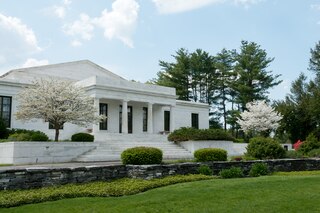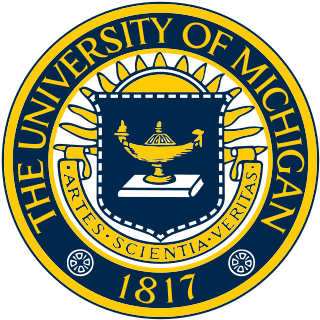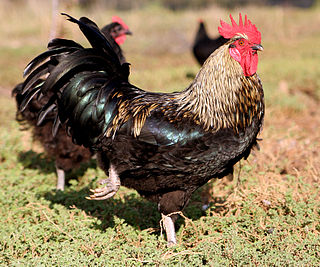
Aesop's Fables, or the Aesopica, is a collection of fables credited to Aesop, a slave and storyteller who lived in ancient Greece between 620 and 564 BCE. Of diverse origins, the stories associated with his name have descended to modern times through a number of sources and continue to be reinterpreted in different verbal registers and in popular as well as artistic media.

The Thomas Fisher Rare Book Library is a library in the University of Toronto, constituting the largest repository of publicly accessible rare books and manuscripts in Canada. The library is also home to the university archives which, in addition to institutional records, also contains the papers of many important Canadian literary figures including Margaret Atwood and Leonard Cohen.

The Sterling and Francine Clark Art Institute, commonly referred to as the Clark, is an art museum and research institution located in Williamstown, Massachusetts, United States. Its collection consists of European and American paintings, sculpture, prints, drawings, photographs, and decorative arts from the fourteenth to the early twentieth century. The Clark, along with the Massachusetts Museum of Contemporary Art and the Williams College Museum of Art (WCMA), forms a trio of art museums in the Berkshires. The institute also serves as a center for research and higher learning. It is home to various research and academic programs, which include the Fellowship Program and the Williams College Graduate Program in the History of Art, as well as one of the most distinguished research libraries in the country, with more than 295,000 volumes in over 72 languages. The Clark is visited by 200,000 people a year.

The University of Michigan Library is the academic library system of the University of Michigan. The university's 38 constituent and affiliated libraries together make it the second largest research library by number of volumes in the United States.

The Monkey and the Cat is best known as a fable adapted by Jean de La Fontaine under the title Le Singe et le Chat that appeared in the second collection of his Fables in 1679 (IX.17). Although there is no evidence that the story existed before the 15th century, it began to appear in collections of Aesop's Fables from the 17th century but is not included in the Perry Index.
Laurentius Abstemius was an Italian writer and professor of philology, born at Macerata in Ancona. His learned name plays on his family name of Bevilaqua (Drinkwater), and he was also known by the Italian name Lorenzo Astemio. A Neo-Latin writer of considerable talents at the time of the Humanist revival of letters, his first published works appeared in the 1470s and were distinguished by minute scholarship. During that decade he moved to Urbino and became ducal librarian, although he was to move between there and other parts of Italy thereafter as a teacher.

The Yale University Library is the library system of Yale University in New Haven, Connecticut. Originating in 1701 with the gift of several dozen books to a new "Collegiate School," the library's collection now contains approximately 14.9 million volumes housed in fifteen university buildings and is the fourth-largest academic library in North America.

Robert Sterling Clark, an heir to the Singer Sewing Machine fortune, was an American art collector, horse breeder, and philanthropist.
The University of British Columbia Library is the library system of the University of British Columbia (UBC). The library is one of the 124 members of the Association of Research Libraries (ARL). In 2017, UBC Library ranked 29th among members of the ARL for the number of volumes in library, making it the third largest Canadian academic library after the University of Toronto and the University of Alberta. However, UBC Library ranked 23rd for the titles held and second in Canada, and had a materials expenditures of $13.8 million, placing it 44th.

Mark Podwal is an artist, author, filmmaker and physician. He may have been best known initially for his drawings on The New York Times Op-Ed page. In addition, he is the author and illustrator of numerous books. Most of these works — Podwal's own as well as those he has illustrated for others— typically focus on Jewish legend, history and tradition. His art is represented in the collections of the Metropolitan Museum of Art, the Victoria and Albert Museum, the Israel Museum, the National Gallery of Prague, the Jewish Museums in Berlin, Vienna, Stockholm, Prague, New York, among many other venues.

John Henry Bradley Storrs, also known as John Bradley Storrs and John H. Storrs, was an American modernist sculptor best remembered for his art deco sculptures that examined the relationship between architecture and sculpture.

Aesop was a Greek fabulist and storyteller credited with a number of fables now collectively known as Aesop's Fables. Although his existence remains unclear and no writings by him survive, numerous tales credited to him were gathered across the centuries and in many languages in a storytelling tradition that continues to this day. Many of the tales associated with him are characterized by anthropomorphic animal characters.

The Cock and the Jewel is a fable attributed to Aesop and is numbered 503 in the Perry Index. As a trope in literature, the fable is reminiscent of stories used in Zen such as the kōan. It presents, in effect, a riddle on relative values and is capable of different interpretations, depending on the point of view from which it is regarded.

Otto Greiner was a German painter and graphic artist.

Jean de La Fontaine collected fables from a wide variety of sources, both Western and Eastern, and adapted them into French free verse. They were issued under the general title of Fables in several volumes from 1668 to 1694 and are considered classics of French literature. Humorous, nuanced and ironical, they were originally aimed at adults but then entered the educational system and were required learning for school children.

The Mary Ann Beinecke Decorative Art Collection is a research collection of more than 1200 volumes on textiles and decorative art subjects, which is held in the Library of the Sterling and Francine Clark Art Institute.

The Thomas J. Watson Library is the main research library of the Metropolitan Museum of Art, and supports the research activities of the museum staff, as well as outside researchers. It is located in the Met's main building, The Met Fifth Avenue.

The David A. Hanson Collection of the History of Photomechanical Reproduction is a collection at the Clark Art Institute Library documenting the history of the development of photography from 1826 to the early 20th century. It includes all kinds of photography as well as books and articles. It was assembled by David A. Hanson.

Francine Clark (1876–1960) was a French actress, art collector, horse breeder, and philanthropist.

Jules Worms was a French academic painter and illustrator. Born into a family of Parisian shopkeepers, he entered the École des Beaux-Arts in 1849 at the age of seventeen, where he studied under Jean-Adolphe Lafosse (1810–79). He made his debut at the Paris Salon of 1859. Worms is best known for genre scenes depicting Spanish life, often comical and painted in a highly realistic manner with many details and bright colors.
![Noah's Ark with Noah's dove. From: Vita beatae Mariae Vir[ginis] matris Dei, emblematib[us] delineata. Vita beatae 47.jpg](http://upload.wikimedia.org/wikipedia/commons/thumb/e/ed/Vita_beatae_47.jpg/220px-Vita_beatae_47.jpg)
![[Detail] Regola delli cinque ordini d'architettura di M. Jac. Barozzio da Vignola (1736). Regola delli cinque 54.jpg](http://upload.wikimedia.org/wikipedia/commons/thumb/d/dc/Regola_delli_cinque_54.jpg/220px-Regola_delli_cinque_54.jpg)
![[Detail] Proteus, ofte, Minne-beelden verandert in sinne-beelden (1627). Proteus ofte 272.jpg](http://upload.wikimedia.org/wikipedia/commons/thumb/0/09/Proteus_ofte_272.jpg/220px-Proteus_ofte_272.jpg)
![[Detail] Della fisionomia dell'huomo (1644). Della fisionomia 229.jpg](http://upload.wikimedia.org/wikipedia/commons/thumb/2/27/Della_fisionomia_229.jpg/220px-Della_fisionomia_229.jpg)

![[Detail] Description des principales pierres gravees du cabinet de S. A. S. Monseigneur le duc d'Orleans, premier prince du sang (1780). Principales pierres 171.jpg](http://upload.wikimedia.org/wikipedia/commons/thumb/b/b5/Principales_pierres_171.jpg/220px-Principales_pierres_171.jpg)




















































